The Tale of the Bell Tower of Giotto
Reading time: 10 min
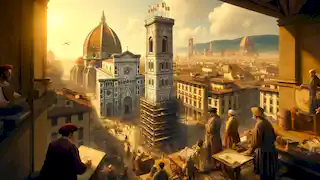
About this story: The Tale of the Bell Tower of Giotto is a Historical Fiction from Italy set in the Renaissance This Descriptive tale explores themes of Perseverance and is suitable for . It offers Historical insights. A tale of resilience, vision, and mystery behind Florence's iconic bell tower.
Introduction
In the heart of Florence, Italy, where the Renaissance left its most profound mark, stands the Campanile di Giotto, the bell tower of Giotto. This architectural marvel, towering over the city since the 14th century, is a tribute not only to the genius of its designer but also to the spirit of a time when art, science, and religion intertwined in a sublime dance of creativity. The tower rises proudly beside the Cathedral of Santa Maria del Fiore, known more commonly as the Duomo, and its elegant silhouette is an integral part of Florence’s skyline. But beyond its physical beauty lies a tale rich with history, mystery, and even legend.
The story of the bell tower, or as it is called in Italian, the campanile, is deeply rooted in the artistic aspirations of its creator, Giotto di Bondone. A master painter, architect, and sculptor, Giotto’s work on the tower was not just an expression of his own talent, but also a symbol of Florence’s growing ambition as the cradle of the Renaissance. Yet, as with any great work of art, the tower’s history is not without its shadows. Behind its magnificent facade are stories of political intrigue, personal sacrifice, and supernatural wonder. This is the tale of the Bell Tower of Giotto—a story of inspiration, beauty, and mystery that spans centuries.
The Vision of Giotto
In the year 1334, Giotto di Bondone was at the height of his career. Having established himself as a leading figure in painting, his natural curiosity and relentless drive for innovation led him to architecture. Florence, then a thriving city-state, had already commissioned its massive cathedral, but the great church still needed a proper bell tower. The design of this tower, they decided, would be entrusted to the brilliant Giotto.
Giotto’s vision for the bell tower was unlike anything seen before. While many contemporary towers were utilitarian in design, his would be a work of art. He imagined a slender structure that would soar to the heavens, its facade adorned with intricate reliefs, sculptures, and geometric patterns. At its core, it would represent the harmony of divine proportions, a theme dear to the hearts of Renaissance thinkers who believed that God’s perfection could be reflected in human creation.
But Giotto’s vision was more than just a reflection of aesthetic ideals—it was a statement. Florence was competing with other Italian cities for cultural dominance, and the bell tower would be a testament to its burgeoning status as a center of innovation and creativity. He spent days laboring over sketches, ensuring that every detail, from the base to the spire, would reflect the city's pride and artistic achievements.
Construction began swiftly. The foundation was laid, and soon the first stones were placed. Giotto himself was often seen on the site, overseeing the workers, adjusting plans, and guiding the process with meticulous care. But as the tower began to rise, so too did tensions within the city.
Political Tensions and Struggles
Florence, while a city of immense beauty, was not immune to the political struggles that plagued much of Italy during the Middle Ages. The city was divided between the Guelphs and Ghibellines, two factions that represented the broader conflict between papal authority and imperial control. While these factions were ostensibly political, they infiltrated every aspect of life in Florence, including the arts.
As the bell tower rose, so did tensions between these factions. Some members of the ruling class felt that Giotto’s tower, with its sheer grandeur and beauty, was a distraction from more pressing issues such as the city’s defense and economy. There were whispers that Giotto, despite his brilliance, was out of touch with the practical needs of Florence, that his dream of a tower reaching to the heavens was an indulgence that the city could ill afford.
Still, Giotto persisted. He believed in the power of beauty to transcend the petty squabbles of politics. He saw the bell tower not just as a monument, but as a symbol of Florence’s divine favor, a reminder that art and faith could lift the city above the mundane and into the celestial realms. But despite his determination, the political turmoil surrounding the construction took its toll.
By 1337, only a small portion of the tower had been completed when Giotto passed away. The master architect had not lived to see his vision come to life, and the future of the bell tower now lay in the hands of others.
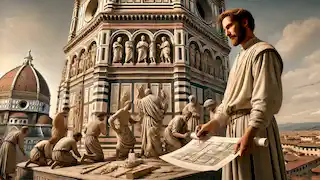
The Continuation of a Dream
Giotto's death left a profound void. The city of Florence mourned not only the loss of a genius but also the uncertainty that now surrounded the completion of the bell tower. However, the city's commitment to its artistic and architectural goals did not falter. Another master of the time, Andrea Pisano, was appointed to continue the work on the campanile.
Pisano, while a gifted artist and architect in his own right, faced the challenge of balancing his own vision with the one that Giotto had laid out. For the first few years, Pisano adhered closely to Giotto's designs, carefully overseeing the addition of intricate reliefs on the lower levels of the tower. These carvings depicted biblical scenes, allegories of human virtues, and the progressive stages of human life, symbolizing the city’s belief in the divine order of the universe.
As work progressed, however, the political climate of Florence became even more volatile. The city's ongoing conflicts with its rival states, coupled with internal power struggles, drained resources from the tower's construction. There were growing concerns that the tower might never be completed, that it would stand as a half-finished testament to Florence's dashed ambitions.
Yet, the people of Florence, inspired by Giotto’s original vision, refused to abandon the project. Despite the hardships, they continued to support the construction, seeing the tower as a symbol of the city’s resilience and determination to rise above adversity.
The Supernatural Encounter
As the years went by, the tower steadily rose. But as it reached its middle levels, strange occurrences began to plague the construction site. Workers reported hearing voices in the night, whispers carried by the wind that seemed to emanate from the stones themselves. Tools would go missing, only to be found in odd locations, and scaffolding would collapse without warning.
These mysterious events soon gave rise to rumors that the tower was cursed. Some believed that Giotto’s spirit was restless, angered that his masterpiece had not been completed according to his wishes. Others thought that the devil himself was trying to sabotage the tower, envious of its beauty and its representation of divine order.
One evening, a young mason by the name of Luca claimed to have seen a ghostly figure walking along the scaffolding. Pale and translucent, the figure moved silently, its hands tracing the stones as if inspecting them. Luca was convinced that the spirit was none other than Giotto, still watching over his creation from beyond the grave.
Word of Luca’s sighting spread quickly through the city. Many dismissed it as the overactive imagination of a young laborer, but others took it as a sign that Giotto’s spirit was indeed lingering, protecting the tower from those who might harm it. As more and more strange events occurred, some workers refused to set foot on the site after dark.
But even as these supernatural tales swirled, construction on the tower continued. The people of Florence were determined to see the project through to completion, despite the growing unease surrounding it.
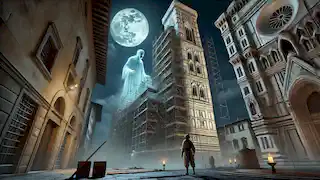
The Final Completion
By the mid-14th century, the bell tower had nearly reached its full height. Yet the city was once again facing challenges, this time in the form of the Black Death. The plague swept through Europe with devastating speed, and Florence was not spared. Thousands of lives were lost, and the city’s population was decimated.
The plague brought construction on the bell tower to a halt. With so many lives lost, there was little energy or resources left to continue the project. But as the plague subsided, Florence, like a phoenix rising from the ashes, resumed its work on the campanile.
In 1359, the bell tower was finally completed, standing at a height of 85 meters (280 feet). The city rejoiced, seeing the tower as a symbol of their resilience in the face of unimaginable hardship. It was not only a testament to Giotto’s original vision but also to the determination and creativity of the many hands that had contributed to its construction over the decades.
Today, the Bell Tower of Giotto stands as one of Florence’s most iconic landmarks, its elegant form still inspiring awe in those who gaze upon it. It is a reminder of the city’s glorious past, its struggles, and its triumphs. And for those who believe in the supernatural, it is said that on certain nights, when the moon is high and the wind is still, the spirit of Giotto can still be seen walking along the tower’s heights, watching over his masterpiece with pride.
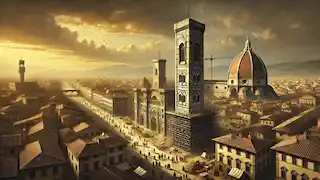
Legacy and Influence
Giotto’s bell tower has influenced countless artists, architects, and scholars over the centuries. Its harmonious design, which balances intricate detail with monumental scale, became a blueprint for future Renaissance architects who sought to combine beauty with function. Brunelleschi, the architect of the Duomo’s famous dome, is said to have been deeply influenced by Giotto’s tower in his own work.
The campanile also became a symbol of Florence’s cultural dominance during the Renaissance. Its completion marked the city’s emergence as a leading center of art and architecture, a status it would maintain for centuries. The tower’s beauty and craftsmanship were a source of immense pride for the people of Florence, and it continues to be celebrated as one of the great architectural achievements of the time.
Beyond its artistic and cultural significance, the Bell Tower of Giotto remains a powerful symbol of human resilience. Throughout its construction, Florence faced political strife, economic hardship, and the ravages of the Black Death. Yet through it all, the people of the city remained committed to completing the tower, seeing it as a beacon of hope and a testament to the enduring power of art.
Today, visitors from around the world flock to Florence to see the bell tower. They climb its narrow stairs, marvel at its intricate reliefs, and gaze out from the top at the breathtaking panorama of the city below. For many, the tower is more than just a historical monument—it is a living testament to the brilliance of Giotto and the spirit of Florence.
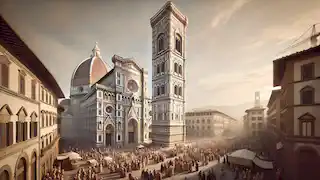
Conclusion
The Tale of the Bell Tower of Giotto is more than just a story of architectural triumph—it is a story of vision, perseverance, and the belief that beauty can transcend the darkest of times. From its inception under the genius of Giotto to its completion after decades of struggle, the bell tower stands as a symbol of the enduring power of art and the resilience of the human spirit. It has withstood the test of time, not only as a masterpiece of design but as a monument to the city that gave birth to the Renaissance.
As we reflect on the tower today, we are reminded of the importance of visionaries like Giotto, who dared to dream beyond the ordinary and left behind a legacy that continues to inspire generations. And perhaps, on a quiet night in Florence, if you listen closely, you might just hear the faint whisper of Giotto’s spirit, still guiding his creation from above.


















